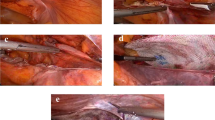Abstract
Background
The Prolene hernia system (PHS) is a three-dimensional mesh device that combines three approaches to hernia repair, but its high cost precludes its widespread use in developing countries. We describe our experience with an indigenous bilayer mesh device that works on a similar principle, and compare its efficacy with conventional PHS.
Materials and Methods
A total of 84 patients with unilateral/bilateral primary uncomplicated inguinal hernia were recruited for the study over a 1-year period and randomized into two groups. Group 1, which consisted of 40 patients, received the indigenous device, and group 2, 44 patients, received conventional PHS. Mean operative time and the patients’ visual assessment scores (VAS) for pain were primary outcome measures. Patient were reviewed in out patients department at intervals of 3 months, and the incidence of complications and recurrence was noted. This was the secondary outcome measure.
Results
The two group were comparable in terms of age, type of hernia, and mean duration of follow-up. The mean operative time was 32.1 min (± 5.5) and 33.25 (± 5.3) in groups 1 and 2, respectively, and the mean VAS score was 2.25 and 2.27 in the respective groups. There was no statistically significant difference. Similarly, the was no significant difference in incidence of complications noted between the two groups (3/40 versus 4/44, respectively). There were no recurrences noted during the period of observation.
Conclusions
The indigenous bilayer device described in this study combines the advantages of two well-publicized techniques of hernia repair: inlay repair and onlay repair. It offers the benefits of conventional PHS repair but is far less expensive and is quite suitable for routine use in centers like ours in a developing nation, where financial resources are a constraint.


Similar content being viewed by others
References
Chandiramani VA, Katara AN, Pandya SM, et al. (2003) Prolene hernia system in the tension-free repair of primary inguinal hernias. Indian J Surg 65:488–491
Kark AE, Kurzer M, Waters KJ (1999) Tension-free mesh repair: review of 1098 cases using local anaesthesia in a day unit. Lancet 354:175–176
Gilbert AI, Graham MF (1995) Improved suture less technique—advice to experts. Prob Gen Surg 12:117–119
Lichtenstein IL, Shulman AG, Amid PK, et al. (1989) The tension-free hernioplasty. Am J Surg 157:188–193
Sanjay P, Harris D, Jones P, Woodward A (2006) Randomized controlled trial comparing Prolene hernia system and Lichtenstein method for inguinal hernia repair Aust N Z J Surg 76:548–552
Vironen J, Nieminen J, Eklund A, et al. (2006) Randomized clinical trial of Lichtenstein patch or Prolene hernia system for inguinal hernia repair. Br J Surg 93:33–39
Author information
Authors and Affiliations
Corresponding author
Rights and permissions
About this article
Cite this article
Chauhan, A., Tiwari, S. & Gupta, A. Study of Efficacy of Bilayer Mesh Device versus Conventional Polypropelene Hernia System in Inguinal Hernia Repair: Early Results. World J Surg 31, 1358–1361 (2007). https://doi.org/10.1007/s00268-007-9047-x
Published:
Issue Date:
DOI: https://doi.org/10.1007/s00268-007-9047-x




